- Turned 26, which was anticlimactic since I had already turned 27 Korean age a few weeks before.
* - Pru came for a week and we went to many palaces and markets and ate lots of food. Some of it was in a tent and some of it was deep fried and on a stick.
- Pru also got me started on K-dramas. We mainlined Secret Garden in four days and now I'm watching a bunch of K-dramas, three of which are about cross dressers (I swear that was an accident) and something called Joseon X-files (oh yeah, aliens in 16th century Korea). *faceplam*
- Said good-bye to Riah, who left for the US. On Tuesday, we made an impromptu scrapbook in Cold Stone and cried on the streets of Gangnam and Audrey and I missed our train home. On Wednesday, I woke up to an email from Riah telling me that the snowstorm that ate America meant that O'Hare was closed until Friday and I got two and a half more days with Riah! Suck it, Midwest! [More here]
- Celebrated 설날 (Seolnal, lunar New Year) by making a spectacle of myself with Riah and Audrey at the aquarium, one of the few places that was open. Welcome to the Year of the Rabbit!
- Adhearing to the rule that you should be as clean as possible before getting on a trans-Pacific flight, the morning before Riah's flight, Audrey, Riah and I went to the bathhouse for a few hours. It was my first time at Dragon Hill Spa, which I liked, especially the outdoor tubs, but my favorite is still the green tea themed spa I went to in Boseong.
- Break is over and students are back for eight whole days before the end of the school year. Yesterday, the 3-1 boys filed in a few minutes ahead of the girls. "Where are the girls?" I asked.
I was solemnly told, "In Seolnal, they is DIE!"
죽을래, which means do you want to die?, is a common expression in Korea and I've heard countless variations of it in English in the past two years, but it still kills** me every time.
Showing posts with label Korean culture. Show all posts
Showing posts with label Korean culture. Show all posts
Wednesday, February 9, 2011
죽을래, Blog?
Long time, no blog. Since I last wrote I have:
* Sokay, in Korea ages are counted differently than in the West. You're one when you're born (none of this X month business for the first year) AND you age on New Years instead of your actual birthday, which means your Korean age can be up to two years older than your Western age. On December 31st, I was 25 US age, 26 Korean age. The next day was New Years, which meant I turned 27 Korean age while I was still 25 US age. Since my birthday is in January, my Korean age is normally only one year ahead of my western age, but my little sister, who just turned sixteen in December is already eighteen in Korea. Somewhere my mother just blanched at the thought.
** Zing!
Tuesday, December 7, 2010
The Amazing Race: Seoul
So, yesterday morning Amber IM'd me to tell me that the latest episode of The Amazing Race was set in Seoul and they went rafting in the DMZ. My response can best be summed up as "..." since I'm pretty sure I would remember an American reality TV show causing an international incident by crossing into the DMZ, an area that is best known for the fact that people CAN'T go there. Even though I don't watch the Amazing Race, I figured this episode would be worth watching.
The teams arrived in Korea and it was raining, which, of course it was raining. The rainy season was abnormally long this year, and by abnormally long, I mean it rained for five straight months. We went weeks without seeing the sun. I thought my shoes would never dry. That weather was what I saw practically ever day from June to October.
On the drive to Seung-il Bridge, Nat or Kat complained that "most of the signs are completely devoid of any sort of English characters." An interesting observation since, in fact, ALL OF THE SIGNS are in English and Korean.
So, I understand why Amber told me the teams were rafting in the DMZ. The teams constantly referenced the DMZ and claimed to be in the DMZ or the DMZ area. I wonder how much of that was added for rating due to the recent tensions because, really, no. They weren't at the DMZ. They were rafting at a popular tourist destination. If the teams were in the DMZ, then so is Seoul. So am I.
Can we talk for a moment about how RIDICULOUS the third challenge (getting from Camp Casey to the World Cup Stadium) was. Like, seriously, they took the subway. The subway where every station is labeled in English. There was ONE transfer. The name of the station they were going to was WORLD CUP STADIUM STATION. How is that a challenge? If I only have to transfer once, I count it a win. Also, Jill and Thomas (the couple) kept sitting the seats reserved for the elderly or the handicapped. Seats that are clearly labeled as such in English and with pictures. I kept cringing because way to Waegukin Smash and give the rest of us a bad name, guys.
The Mokdong Ice Rink (home to the fourth challenge) is one of the two evacuation spots for Americans in Seoul should the Norks invade. The more you know....
I'm sad none of the groups opted for the Namdaemun challenge because Namdaemun is pretty awesome. It's also a lot more authentically Korean than an ice rink. Plus, I've had the ginseng tonic (the nurse at my school gives it to me whenever I'm sick) and it's not half bad.
I LOVED the shots of the teams trying to hail a taxi and failing. It's next to impossible to hail a taxi on the side of the road in Seoul You have to go to a taxi stop and wait in line.
The Pit Stop - the Temple of Heaven - is a super obscure location. I had never heard of it and according to Google, in 1968 the Westin Hotel was built on the site and the temple is now part of the hotel complex. It's essentially a knock-off of a Chinese temple build by the dying throes of Imperial Korea. There are so many better places that could have been chosen.
I enjoyed this episode, but I don't think I could watch the show on a regular basis. Too many of the contestants act like arrogant, entitled assholes and embodied every negative sterotype people have about Americans. When they were searching for the statue of the airplane at Hangang Park, Thomas gripped, "How does nobody know what an airplane is?" and I had to pause the show so I could shout, "I don't know, maybe because airplane is ENGLISH and you're in KOREA, jackass. Try asking for the 비행기, but wait, you don't speak in Korean. You just expect everyone to speak English." I might be overly sensative because I do live in Korea and know enough about the culture to notice when the contestants are overtly rude, but it was still a constant sorce of annoyance for the entire episode.
The teams arrived in Korea and it was raining, which, of course it was raining. The rainy season was abnormally long this year, and by abnormally long, I mean it rained for five straight months. We went weeks without seeing the sun. I thought my shoes would never dry. That weather was what I saw practically ever day from June to October.
On the drive to Seung-il Bridge, Nat or Kat complained that "most of the signs are completely devoid of any sort of English characters." An interesting observation since, in fact, ALL OF THE SIGNS are in English and Korean.
So, I understand why Amber told me the teams were rafting in the DMZ. The teams constantly referenced the DMZ and claimed to be in the DMZ or the DMZ area. I wonder how much of that was added for rating due to the recent tensions because, really, no. They weren't at the DMZ. They were rafting at a popular tourist destination. If the teams were in the DMZ, then so is Seoul. So am I.
Can we talk for a moment about how RIDICULOUS the third challenge (getting from Camp Casey to the World Cup Stadium) was. Like, seriously, they took the subway. The subway where every station is labeled in English. There was ONE transfer. The name of the station they were going to was WORLD CUP STADIUM STATION. How is that a challenge? If I only have to transfer once, I count it a win. Also, Jill and Thomas (the couple) kept sitting the seats reserved for the elderly or the handicapped. Seats that are clearly labeled as such in English and with pictures. I kept cringing because way to Waegukin Smash and give the rest of us a bad name, guys.
The Mokdong Ice Rink (home to the fourth challenge) is one of the two evacuation spots for Americans in Seoul should the Norks invade. The more you know....
I'm sad none of the groups opted for the Namdaemun challenge because Namdaemun is pretty awesome. It's also a lot more authentically Korean than an ice rink. Plus, I've had the ginseng tonic (the nurse at my school gives it to me whenever I'm sick) and it's not half bad.
I LOVED the shots of the teams trying to hail a taxi and failing. It's next to impossible to hail a taxi on the side of the road in Seoul You have to go to a taxi stop and wait in line.
The Pit Stop - the Temple of Heaven - is a super obscure location. I had never heard of it and according to Google, in 1968 the Westin Hotel was built on the site and the temple is now part of the hotel complex. It's essentially a knock-off of a Chinese temple build by the dying throes of Imperial Korea. There are so many better places that could have been chosen.
I enjoyed this episode, but I don't think I could watch the show on a regular basis. Too many of the contestants act like arrogant, entitled assholes and embodied every negative sterotype people have about Americans. When they were searching for the statue of the airplane at Hangang Park, Thomas gripped, "How does nobody know what an airplane is?" and I had to pause the show so I could shout, "I don't know, maybe because airplane is ENGLISH and you're in KOREA, jackass. Try asking for the 비행기, but wait, you don't speak in Korean. You just expect everyone to speak English." I might be overly sensative because I do live in Korea and know enough about the culture to notice when the contestants are overtly rude, but it was still a constant sorce of annoyance for the entire episode.
Friday, November 12, 2010
Introducing 태세종
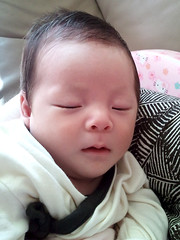 A few weeks ago, Yeong Eun, the former 6th grade co-teacher, had her baby, a little boy named Sejong, and on Wednesday, the 3rd grade teachers, Nicole and I went to visit her. (The different special area teachers are grouped with different grades for administrative purposes, so the English teachers are all considered 3rd grade teachers, even though only two of us actually teach 3rd grade.) We used our cultural activity day
A few weeks ago, Yeong Eun, the former 6th grade co-teacher, had her baby, a little boy named Sejong, and on Wednesday, the 3rd grade teachers, Nicole and I went to visit her. (The different special area teachers are grouped with different grades for administrative purposes, so the English teachers are all considered 3rd grade teachers, even though only two of us actually teach 3rd grade.) We used our cultural activity dayYeong Eun is observing samchilil (삼칠일), literally 21 Days, the traditional Korean postpartum rituals. Samchilil requires that mother and child stay warm and cloistered in the house for the first twenty-one days, and that the mother primarily eat seaweed soup (미역국) and avoid anything cold, spicy or hard. They also aren't allowed to bath for the three weeks following birth. All this is to ease the child's transition from the womb to real life, but apparently doesn't preclude visitors. Sejong (who was named after the most famous of the Korean monarchs) is an adorable baby. He slept most of the visit, but he was constantly making faces and rolling his eyes, which was hilarious. I got to hold him for a long while, which reduced to me cooing puddle of baby talk, which only my co-teachers noticed, since none of the third grade teachers could understand me to begin with.

Welcome to the world, baby boy.
Thursday, November 11, 2010
Pepero Day!
 Today is both the start of the G20 Summit and Pepero Day. I'll admit, I'm enjoying the irony of Seoul hosting a conference for twenty of the world's largest economies during one of the most crassly commercial holiday I've ever heard of. Pepero Day was dreamt up less than twenty years ago by Lotte, the manufacturers of Pepero, as a way to boost sales. The date was chosen because, held side-by-side, four sticks of Pepero look like 11/11. And it works; over half of Pepero sales in Korea are during November. Every convenience store I've been in for the past week has had a huge Pepero display next to the register and my students spend today running around the school, handing out Pepero, demanding Pepero from their friends and in general Pepero Pepero 빼빼로!
Today is both the start of the G20 Summit and Pepero Day. I'll admit, I'm enjoying the irony of Seoul hosting a conference for twenty of the world's largest economies during one of the most crassly commercial holiday I've ever heard of. Pepero Day was dreamt up less than twenty years ago by Lotte, the manufacturers of Pepero, as a way to boost sales. The date was chosen because, held side-by-side, four sticks of Pepero look like 11/11. And it works; over half of Pepero sales in Korea are during November. Every convenience store I've been in for the past week has had a huge Pepero display next to the register and my students spend today running around the school, handing out Pepero, demanding Pepero from their friends and in general Pepero Pepero 빼빼로!
Saturday, November 6, 2010
Ulleungdo, Mysterious Island: Day 2
Ulleungdo, day 2. On Monday morning, the group went on a bus ride around Ulleungdo. Ulleungdo is small, but there isn't a road the circumnavigates that island, so we drove most of the way around the island, and then turned around and drove back the same way. There are a number of rock formations that supposedly look like animals just off the coast and the bus driver took care to point out every single one in great detail. That rock is a turtle, diving in the ocean, with a baby turtle on its back and that right there is the baby turtle's man penis. This is the elephant rock and the small rock behind it? Yeah, that's the elephant's dung. Near the end of the tour, we drove through a natural stone bridge that is suppose to look like a vagina. Male drivers like to drive part way through, back up and drive through again. They also like to say, "I'm coming," as they drive through and sometimes hit the windshield wiper spray as he drove through. Stay classy, adjoshi.
After the bus ride and lunch, a smaller group took the ferry to Dokdo. Dokdo is... it's complicated. Dokdo is comprised of two main islets and 35 smaller rocks in the middle of of a watery nowhere that is right smack dab in between Korea and Japan. Both countries claim sovereignty over the rocks, and while Dokdo is situated over rich fishing grounds and a possible natural gas reservoir, the controversy has less to do with economics and more to do with the 400-year-long feud between Korea and Japan and Korea's lingering resentment over Japanese invasions. This is Japan vs. Korea, round three thousand, and it has become a matter of intense nationalistic importance in Korea. While Dokdo is disputed territory, it is administered by South Korea and the only residents are Korean. There is a daily ferry between Ulleungdo and Dokdo for tourists, and after a year and a half of seeing adds about Dokdo, hearing songs about Dokdo, seeing kindergarteners dressed like the Korean flag dance about Dokdo and having tiny 4th graders beseechingly tell me, "Teacher, Dokdo is Korea," I wasn't going to pass up the chance to see the island for myself.
I've now been to Dokdo and, well, they're rocks. Rocks in the middle of nowhere, but if I have to choose a side, I'm on Team Korea. Visitors were restricted to the wharf, but Caroline and I clambered up the rocky sides of the island, and if we can't say we've stood on Dokdo, we can at least claim to have perched precariously on Dokdo. We played rock-paper-scissors since it was the most Korean thing we could think of besides kimchi, and neither of us had any kimchi handy.
It rained pretty much the entire first two days. From the sporadic rain Sunday morning (a rude awakening to my beach nap, let me tell you) to the pouring rain Sunday night which canceled the cable car trip to the light mist that obscured views during the bus ride, it was a wet trip, and while on Dokdo, I overheard some of the staff talking about a big storm that might shut down the ferries and leave us stranded on the island. Monday night, the Adventure Korea staff told us that due to an approaching storm, the ferries back to the mainland would be closed on Wednesday, Thursday and possible Friday and, faced with the options of either being stranded on Ulleungdo, five to a hotel room, during heavy rains or leaving a day and a half early, they had decided to cut the trip short. An extra ferry would be running the next day at noon to take people back to the mainland, and we had less than twenty four hours left on Ulleungdo.
One of the bridges along the Haengnam Shore Walkway crossed over a cove wide enough and deep enough to jump into. On Sunday's hike, part of the group had jumped off the bridge and gone swimming, but I hadn't wanted to finish the hike in a wet bathing suit, so I stayed on dry land and planned to come back later in the trip. Thanks to the change in departure, my only chance was to go that night, so after dinner, Caroline and I donned bathing suits and walked back to the trail to go swimming. At first we weren't going to jump on the bridge; it was five or six hours later than when people had original jumped, we weren't sure how the tide might have affected the water depth and the lights on that section of the walkway were out, so we would be jumping blind. We climbed down the side of the coast next to the bridge to check the water, and while it seemed deep enough, we discovered that the railing along the walkway was mildly electrified. We couldn't feel it when we were dry, but once we were wet, it stung like a bitch every time we touched the metal railing. Instead of electrocuting ourselves, we decided to just go swimming in the East Sea and, come time to get out, scare the bejesus out the Koreans dinning on the nearby dimly-lit beach by rising out of the waters like some 외국인 Monsters From the Black Lagoon. While we were swimming, a Korean family hiking along the pathway above noticed us and shouted out a greeting.
"Hi," the little girl shouted to us.
"Hi," Caroline and I shouted back, and immediately she launched into a torrent of broken English. Who are you? Where are you from? What are you doing? Do you like kimchi? I love Korea! At one point I asked her how old she was and her father, who was standing next to her, shouted back, "I am 41 years old."
We swam until we started to get cold, and then walked back to our clothes at the bridge. While we were drying off, the Adventure Korea staff showed up, a bit drunk, to go bridge jumping. Caroline and I warned them about the electrified fence, but since they were dry and couldn't feel it, they didn't believe us until after they had jumped into the ocean and were electrified trying to slither under the fence back onto the walkway. There was lots of shouting and swearing and laughing (from Caroline and me). After a few jumps, the staff convinced Caroline and I to join in, and I ended up jumping off the bridge once. It wasn't that high of a jump, or at least that's what I thought until I had climbed over the railing on the bridge and was looking into the dark ocean below and realized that, oh crap, I was going to have to let go of my death grip on the rail. It was a lot of fun, though, and worth that brief moment of panic.
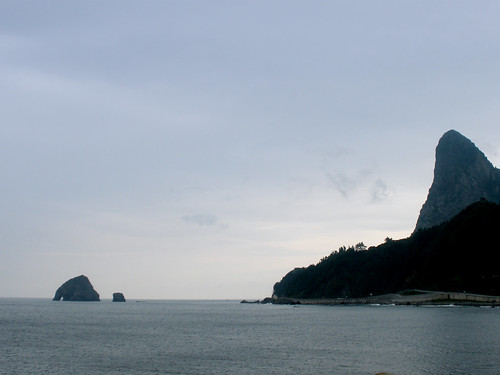
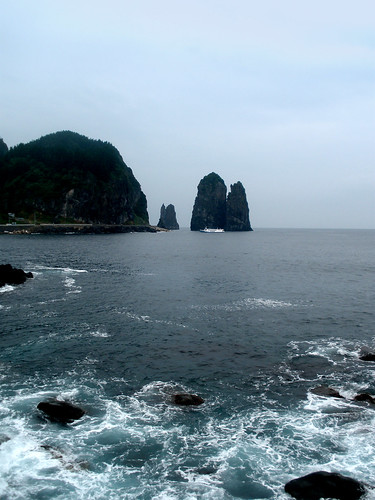
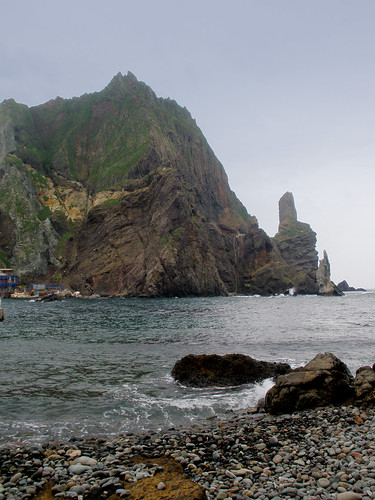
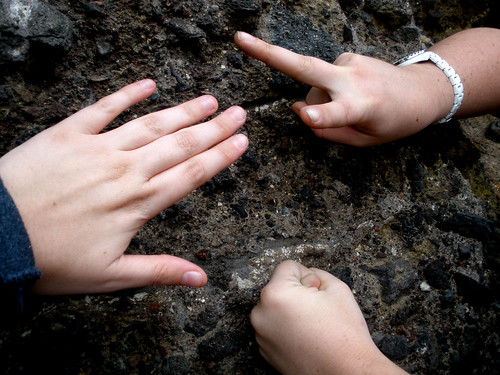
Top: Elephant Rock with elephant poop; Middle: Samseonam Rocks representing "the three fairies who were stuck on views here changed to those three rocks," according to the guide I picked up at the minbak (left), Seodo (western islet) of Dokdo (right); Bottom: 가위바위보! Dokdo is Korea!
More photos are here.
After the bus ride and lunch, a smaller group took the ferry to Dokdo. Dokdo is... it's complicated. Dokdo is comprised of two main islets and 35 smaller rocks in the middle of of a watery nowhere that is right smack dab in between Korea and Japan. Both countries claim sovereignty over the rocks, and while Dokdo is situated over rich fishing grounds and a possible natural gas reservoir, the controversy has less to do with economics and more to do with the 400-year-long feud between Korea and Japan and Korea's lingering resentment over Japanese invasions. This is Japan vs. Korea, round three thousand, and it has become a matter of intense nationalistic importance in Korea. While Dokdo is disputed territory, it is administered by South Korea and the only residents are Korean. There is a daily ferry between Ulleungdo and Dokdo for tourists, and after a year and a half of seeing adds about Dokdo, hearing songs about Dokdo, seeing kindergarteners dressed like the Korean flag dance about Dokdo and having tiny 4th graders beseechingly tell me, "Teacher, Dokdo is Korea," I wasn't going to pass up the chance to see the island for myself.
I've now been to Dokdo and, well, they're rocks. Rocks in the middle of nowhere, but if I have to choose a side, I'm on Team Korea. Visitors were restricted to the wharf, but Caroline and I clambered up the rocky sides of the island, and if we can't say we've stood on Dokdo, we can at least claim to have perched precariously on Dokdo. We played rock-paper-scissors since it was the most Korean thing we could think of besides kimchi, and neither of us had any kimchi handy.
It rained pretty much the entire first two days. From the sporadic rain Sunday morning (a rude awakening to my beach nap, let me tell you) to the pouring rain Sunday night which canceled the cable car trip to the light mist that obscured views during the bus ride, it was a wet trip, and while on Dokdo, I overheard some of the staff talking about a big storm that might shut down the ferries and leave us stranded on the island. Monday night, the Adventure Korea staff told us that due to an approaching storm, the ferries back to the mainland would be closed on Wednesday, Thursday and possible Friday and, faced with the options of either being stranded on Ulleungdo, five to a hotel room, during heavy rains or leaving a day and a half early, they had decided to cut the trip short. An extra ferry would be running the next day at noon to take people back to the mainland, and we had less than twenty four hours left on Ulleungdo.
One of the bridges along the Haengnam Shore Walkway crossed over a cove wide enough and deep enough to jump into. On Sunday's hike, part of the group had jumped off the bridge and gone swimming, but I hadn't wanted to finish the hike in a wet bathing suit, so I stayed on dry land and planned to come back later in the trip. Thanks to the change in departure, my only chance was to go that night, so after dinner, Caroline and I donned bathing suits and walked back to the trail to go swimming. At first we weren't going to jump on the bridge; it was five or six hours later than when people had original jumped, we weren't sure how the tide might have affected the water depth and the lights on that section of the walkway were out, so we would be jumping blind. We climbed down the side of the coast next to the bridge to check the water, and while it seemed deep enough, we discovered that the railing along the walkway was mildly electrified. We couldn't feel it when we were dry, but once we were wet, it stung like a bitch every time we touched the metal railing. Instead of electrocuting ourselves, we decided to just go swimming in the East Sea and, come time to get out, scare the bejesus out the Koreans dinning on the nearby dimly-lit beach by rising out of the waters like some 외국인 Monsters From the Black Lagoon. While we were swimming, a Korean family hiking along the pathway above noticed us and shouted out a greeting.
"Hi," the little girl shouted to us.
"Hi," Caroline and I shouted back, and immediately she launched into a torrent of broken English. Who are you? Where are you from? What are you doing? Do you like kimchi? I love Korea! At one point I asked her how old she was and her father, who was standing next to her, shouted back, "I am 41 years old."
We swam until we started to get cold, and then walked back to our clothes at the bridge. While we were drying off, the Adventure Korea staff showed up, a bit drunk, to go bridge jumping. Caroline and I warned them about the electrified fence, but since they were dry and couldn't feel it, they didn't believe us until after they had jumped into the ocean and were electrified trying to slither under the fence back onto the walkway. There was lots of shouting and swearing and laughing (from Caroline and me). After a few jumps, the staff convinced Caroline and I to join in, and I ended up jumping off the bridge once. It wasn't that high of a jump, or at least that's what I thought until I had climbed over the railing on the bridge and was looking into the dark ocean below and realized that, oh crap, I was going to have to let go of my death grip on the rail. It was a lot of fun, though, and worth that brief moment of panic.




Top: Elephant Rock with elephant poop; Middle: Samseonam Rocks representing "the three fairies who were stuck on views here changed to those three rocks," according to the guide I picked up at the minbak (left), Seodo (western islet) of Dokdo (right); Bottom: 가위바위보! Dokdo is Korea!
More photos are here.
Wednesday, November 3, 2010
GEPIK Training: Korean Culture Tour

I had GEPIK training last Wednesday. GEPIK is the program in charge of native English teachers in the Gyeonggi public schools. Periodically they hold training sessions and I make faces and complain because I'm a bitter cynic, but last week's training was a Korean Culture Tour, so I was marginally interested. It was suppose to be for new GEPIK teachers - most of the other teachers had only been in Korea for a month or two, and one girl had only been here for five days - and I'm not quite sure why I was included, since I'm new to neither Korea nor GEPIK. There had been a cold snap the day before and I got to play the part of grizzled veteran as the newer teachers asked about the weather. No, your school isn't going to start heating the hallways, and yes, the windows will stay open all winter. Just wait until January when you have students wearing six layers asking you to open the window because they're so hot. On the plus side, it only took me a year to start eating kimchi and K-pop is actually quite catchy. WELCOME TO KOREA!
We went to Gyeongbokgung, the Palace Greatly Blessed by Heaven, the largest and most important of the Five Grand Palaces of Seoul. I visited last year, but I hadn't been back since the restorations of the main gate were completed and I had wanted to visit at least one of the palaces this fall when the leaves were changing, just to take pictures. We arrived just as the changing of the guard ceremony started and once we started the tour, we immediately ran into a royal procession near Gyeonghoeru Pavilion. The royal procession included Korean and English narration and my favorite part of the day was the poor man, dressed in the traditional jeonbok, draped with speakers for the guide's PA system. I laughed and laughed, although I waited until after I look the photo to do it because, dude, embarrassing historical costumes and the long suffering faces of those wearing them, I know thee well.

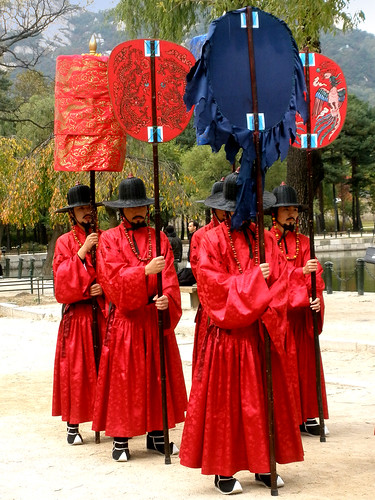
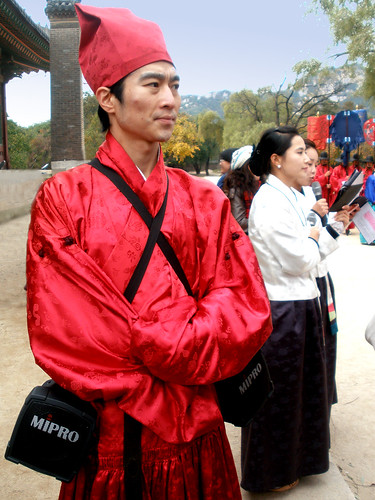
We were taken on a guided tour of the palace, which was actually pretty great because it meant I could ask question - my geekiness, let me show it to you - and I finally, after two years here, learned the named of the traditional eaves painting that I've seen at every temple, palace and gate I've visited in this country. (Dancheong (단청), by the way, and since I didn't write it down, I still had to spend a solid half hour Googling to find it again once I was home.) The last stop was the National Folk Museum of Korea, which we didn't actually visit. Instead we huddled by a group of twelve statues, each one representing one of the animals of the Chinese zodiac. It also listed the dates of each animal, which is how I learned that the placemats at every Chinese buffet I've ever been to were LYING TO ME and thanks to discrepancies between the solar and lunar new years, I was actually born in the year of the rat, not the year of the ox. Quite a blow for a girl to find out she's forthright, tenacious and intense instead of dependable, ambitious, calm as this point in her life.

Dancheong painting on the upturned eaves of the Gyotaejeon.

Bridge to Hyangwonjeong Pavilion
The rest of the photos are here.
Tuesday, August 24, 2010
The DMZ
When I mentioned to people back home that I now live in Korea, the most common response is something along the lines of "OMG, North Korea!!!!1" This is because North Korea is the only thing most Americans know about the Korean Peninsula. (In fact, many Americans seem a bit unsure as to how many Koreas there are. Here's a hint. There are two of them.) I live less than 50 miles from the most heavily militarized border in the world, but the truth is that the possible threat of Communist invasion isn't something I spend time worrying about. There are the occasional air raid sirens, soldiers on the subway and the annual war games, and every so often North Korea threatens to end 1953 ceasefire (technically North and South Korea are still at war) or sinks a South Korean Pohang-class corvette killing 46 seamen and I get a flurry of emails asking me when I'm coming home, but if you're going to live in South Korea, you learn to adopt a blasé attitude towards North Korea or you'll go insane.
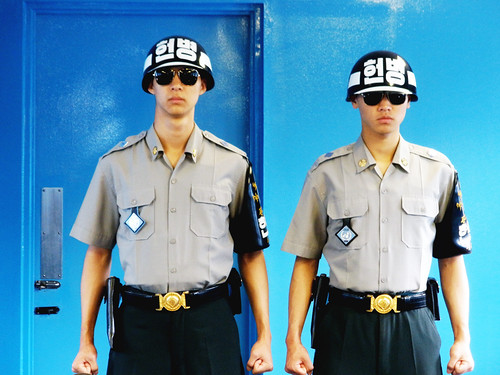
Guards in the Mac Conference Room at the JSA
The point of all this is that I do live very close to the border, and while Mom and Leah were here, we took a trip north to the DMZ. (I had been to the DMZ once before when Sarah visited last summer, but we happened to visit the same Bill Clinton went to North Korea to free the two captured journalists, and halfway through the tour, we were packed into a bus and evacuated due to security concerns.) Our tour started at Camp Bonifas, the United Nations Command military post located a couple hundred meters south of the DMZ. We signed disclaimers telling us that the visit to the Joint Security Area at Panmunjom will entail entry into a hostile area and the possibility of injury or death as a direct result of enemy action, boarded a bus, drove past the most dangerous hole in golf and entered the DMZ. Most people assume that the DMZ is completely isolated, which isn't actually true. The Joint Security Area (JSA) lies within the DMZ, as well as the South Korean town of Daeseong-dong and the North Korean town of Kijong-dong.
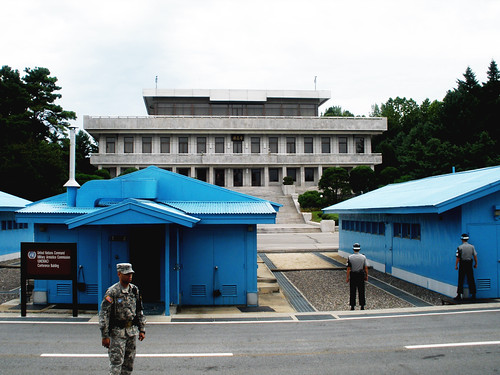
Looking across Conference Row towards North Korea
The first part of the tour visited the JSA. The JSA, with its iconic blue buildings and soldiers staring each other down with clenched fists, is the only official crossing point along the DMZ and the only part of the Korean Peninsula where representatives from the two Koreas meet. We were allowed into the MAC Conference Building, used for talks between North Korea, South Korea and the United Nations Command. The Military Demarcation Line (MDL) runs through the center of the conference building. We were allowed to walk freely through the conference building, meaning I crossed the border into North Korea, if only on a technicality. (The MDL is the actual border between North and South Korea; the DMZ is the 2 km buffer on either side of the MDL.) The next stop was Observation Post #5 for a view of Kijong-dong, the North Korean town located within the DMZ. Kijong-dong is a Potemkin village; it was built by the North Korean in the 1950s for propaganda purposes and the site was never occupied. It is, however, home to the largest flagpole in the world. In the 1970s, the South Korean village of Daeseong-dong, also located within the DMZ, built a new 100m flagpole that was taller than the flagpole in Kijong-dong. The North Koreans responded by erecting a 160 m tall flagpole flying a 600 lb flag at Kijong-dong. The Cold War: two countries getting into a pissing contest over the size of their giant phallic objects.
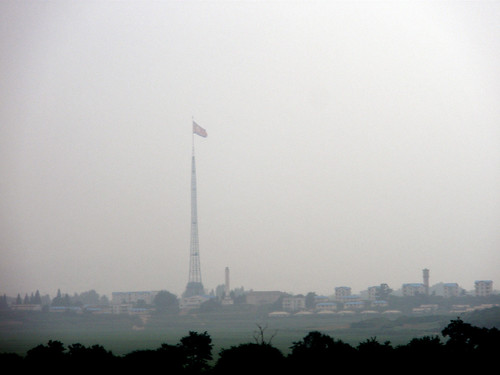
Flagpole at Kijong-dong. Also seen, pollution!
We continued on to the site of the Axe Murder Incident and the Bridge of No Return. On August 18, 1976, North Korean troops attacked a United Nations Command security team guarding a tree trimming detail and axed two American soldiers to death. The UN Command responded with Operation Paul Bunyan, the most expensive tree trimming operation in military history. Arriving in a convoy of twenty three vehicles guarded by two 30-man security platoons from the Joint Security Force and a 64-man ROK special forces company and supported by Cobra attack helicopters, B-52 bombers, F-4 fighters jets, F-5 fighter jets, F-111 fighter jets and the US aircraft carrier Midway, sixteen military engineers chopped the offending poplar tree down with EXTREME PREJUDICE. They trimmed the hell out of that tree. Nearby is the ominous sounding Bridge of No Return, built in 1953 to exchange prisoners at the end of the Korean War.
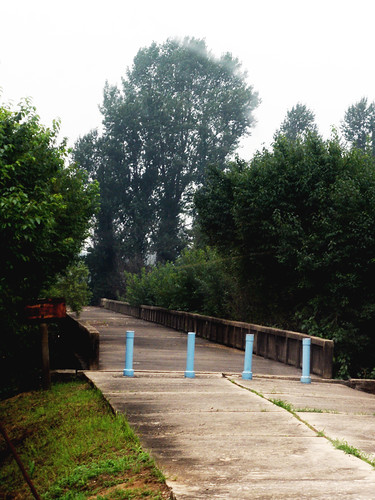
The Cold War blessed the world with both nuclear proliferation and some very dramatic names. Here's the Bridge of No Return.
From there we left the JSA (with a brief stop at the Camp Bonifas gift shop; this might be one of the last outposts of the Cold War, but it's still Korea and I'm just surprised there's not a theme park nearby) and drove to the Third Tunnel of Aggression. The Third Tunnel is the third of four tunnels under the DMZ discovered by South Korea since 1974. The North Koreans have treated the DMZ a little like the obstacles in the children's book We're Going On a Bear Hunt. Uh-uh! A demilitarized zone! A heavily fortified demilitarized zone. We can't go through it. We can't go over it. Oh no! We've got to go under it! Discovered in 1978, the Third Tunnel runs from North Korea into South Korea, is only twenty-seven miles from Seoul and can accommodate 30,000 men per hour along with light weaponry. Now it is a tourist attraction and visitors can don hard hats, descend into the tunnel and walk the two km from the edge of the DMZ to the MDL. The tunnel is low and small and I pity the soldier who has to carry his gear on his back through that tunnel.
The last two stops were the Dora Observatory where, on a clear day (what, we sometimes have clear days in Korea) you can see the North Korean city of Kaesong, and Dorasan Station, the northernmost station on the South Korean side of the Gyeongui Line. One of the oldest railway lines in Korea, the Gyeongui Line originally ran the length of the Korean Peninsula, but has been closed since 1945. It opened briefly from 2007-2008, with freight trains carrying materials to the Kaesong Industrial Region, but closed again after only a year of operation. Dorasan Station, whose motto is "Not the last station from the south, but the first station towards the North," isn't currently serving any trains, but there are signs listing both Seoul and Pyeongyang as destinations.
The trip to the DMZ is a stark reminder of the tension between North and South Korea. The road north from Seoul is lined with barbed wire, guard posts and trenches and during the tour, we were told about the long lists of incidents along the DMZ. Over 500 South Koreans and 50 American soldiers have been killed in skirmishes along the border since the armistice was signed in 1953. It was also a stark reminder of things I don't like to think about. The Seoul area, with a population of twenty-five million people, is just a stone's throw from the North Korean border. Kim Jong-il doesn't need the long-range missiles his country is developing to attack Seoul: short-range missiles from along the DMZ could easily hit the capital, and the sinking of the Cheonan is a clear sign that the dangers aren't all in the past. Something has to give on this peninsula. It's not something I worry about, or even really think about, but every time I hear the air raid sirens or get an email from home, asking what is happening with North Korea, I'm reminded, just for a second, that I live in a country with an emergency evacuation plan.
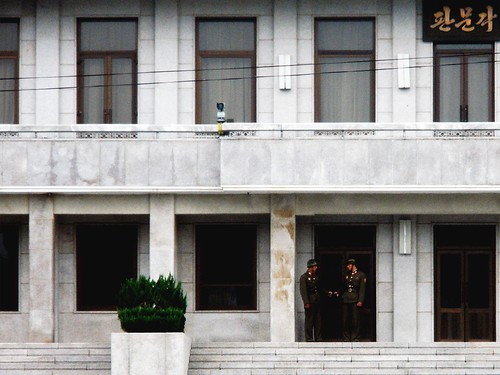
Just remember: the Norks are always watching.

Guards in the Mac Conference Room at the JSA
The point of all this is that I do live very close to the border, and while Mom and Leah were here, we took a trip north to the DMZ. (I had been to the DMZ once before when Sarah visited last summer, but we happened to visit the same Bill Clinton went to North Korea to free the two captured journalists, and halfway through the tour, we were packed into a bus and evacuated due to security concerns.) Our tour started at Camp Bonifas, the United Nations Command military post located a couple hundred meters south of the DMZ. We signed disclaimers telling us that the visit to the Joint Security Area at Panmunjom will entail entry into a hostile area and the possibility of injury or death as a direct result of enemy action, boarded a bus, drove past the most dangerous hole in golf and entered the DMZ. Most people assume that the DMZ is completely isolated, which isn't actually true. The Joint Security Area (JSA) lies within the DMZ, as well as the South Korean town of Daeseong-dong and the North Korean town of Kijong-dong.

Looking across Conference Row towards North Korea
The first part of the tour visited the JSA. The JSA, with its iconic blue buildings and soldiers staring each other down with clenched fists, is the only official crossing point along the DMZ and the only part of the Korean Peninsula where representatives from the two Koreas meet. We were allowed into the MAC Conference Building, used for talks between North Korea, South Korea and the United Nations Command. The Military Demarcation Line (MDL) runs through the center of the conference building. We were allowed to walk freely through the conference building, meaning I crossed the border into North Korea, if only on a technicality. (The MDL is the actual border between North and South Korea; the DMZ is the 2 km buffer on either side of the MDL.) The next stop was Observation Post #5 for a view of Kijong-dong, the North Korean town located within the DMZ. Kijong-dong is a Potemkin village; it was built by the North Korean in the 1950s for propaganda purposes and the site was never occupied. It is, however, home to the largest flagpole in the world. In the 1970s, the South Korean village of Daeseong-dong, also located within the DMZ, built a new 100m flagpole that was taller than the flagpole in Kijong-dong. The North Koreans responded by erecting a 160 m tall flagpole flying a 600 lb flag at Kijong-dong. The Cold War: two countries getting into a pissing contest over the size of their giant phallic objects.

Flagpole at Kijong-dong. Also seen, pollution!
We continued on to the site of the Axe Murder Incident and the Bridge of No Return. On August 18, 1976, North Korean troops attacked a United Nations Command security team guarding a tree trimming detail and axed two American soldiers to death. The UN Command responded with Operation Paul Bunyan, the most expensive tree trimming operation in military history. Arriving in a convoy of twenty three vehicles guarded by two 30-man security platoons from the Joint Security Force and a 64-man ROK special forces company and supported by Cobra attack helicopters, B-52 bombers, F-4 fighters jets, F-5 fighter jets, F-111 fighter jets and the US aircraft carrier Midway, sixteen military engineers chopped the offending poplar tree down with EXTREME PREJUDICE. They trimmed the hell out of that tree. Nearby is the ominous sounding Bridge of No Return, built in 1953 to exchange prisoners at the end of the Korean War.

The Cold War blessed the world with both nuclear proliferation and some very dramatic names. Here's the Bridge of No Return.
From there we left the JSA (with a brief stop at the Camp Bonifas gift shop; this might be one of the last outposts of the Cold War, but it's still Korea and I'm just surprised there's not a theme park nearby) and drove to the Third Tunnel of Aggression. The Third Tunnel is the third of four tunnels under the DMZ discovered by South Korea since 1974. The North Koreans have treated the DMZ a little like the obstacles in the children's book We're Going On a Bear Hunt. Uh-uh! A demilitarized zone! A heavily fortified demilitarized zone. We can't go through it. We can't go over it. Oh no! We've got to go under it! Discovered in 1978, the Third Tunnel runs from North Korea into South Korea, is only twenty-seven miles from Seoul and can accommodate 30,000 men per hour along with light weaponry. Now it is a tourist attraction and visitors can don hard hats, descend into the tunnel and walk the two km from the edge of the DMZ to the MDL. The tunnel is low and small and I pity the soldier who has to carry his gear on his back through that tunnel.
The last two stops were the Dora Observatory where, on a clear day (what, we sometimes have clear days in Korea) you can see the North Korean city of Kaesong, and Dorasan Station, the northernmost station on the South Korean side of the Gyeongui Line. One of the oldest railway lines in Korea, the Gyeongui Line originally ran the length of the Korean Peninsula, but has been closed since 1945. It opened briefly from 2007-2008, with freight trains carrying materials to the Kaesong Industrial Region, but closed again after only a year of operation. Dorasan Station, whose motto is "Not the last station from the south, but the first station towards the North," isn't currently serving any trains, but there are signs listing both Seoul and Pyeongyang as destinations.
The trip to the DMZ is a stark reminder of the tension between North and South Korea. The road north from Seoul is lined with barbed wire, guard posts and trenches and during the tour, we were told about the long lists of incidents along the DMZ. Over 500 South Koreans and 50 American soldiers have been killed in skirmishes along the border since the armistice was signed in 1953. It was also a stark reminder of things I don't like to think about. The Seoul area, with a population of twenty-five million people, is just a stone's throw from the North Korean border. Kim Jong-il doesn't need the long-range missiles his country is developing to attack Seoul: short-range missiles from along the DMZ could easily hit the capital, and the sinking of the Cheonan is a clear sign that the dangers aren't all in the past. Something has to give on this peninsula. It's not something I worry about, or even really think about, but every time I hear the air raid sirens or get an email from home, asking what is happening with North Korea, I'm reminded, just for a second, that I live in a country with an emergency evacuation plan.

Just remember: the Norks are always watching.
Saturday, July 3, 2010
Buddha's Birthday
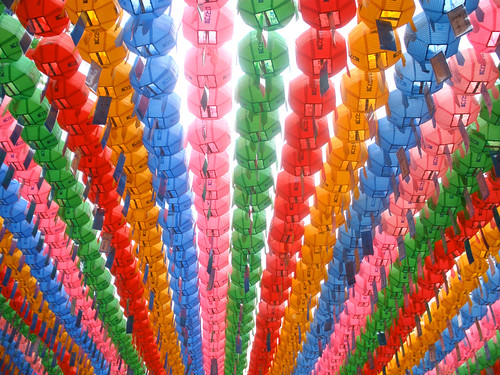
In Korea, Buddha's birthday is celebrated on the 8th day of the 4th lunar month. This year, it fell on May 21st. (Yes, I know that's over a month ago. This is catch-up blogging from the great blogging void of April and May 2010. ) Buddhism was introduced to Korea in 372 AD, and was the dominate religion on the peninsula until the rise of the Joseon Dynasty in 1392. Despite persecution during the early Joseon period, Buddhism remains one of the major religions in Korea today. (According to a survey by the South Korean National Statistical Office, 22.8% of Koreans are Buddhist, 29.2% are some form of Christian and 46.4% of Koreans are atheist which, as someone who comes from a country where religion is such a pervasive part of the culture, is something I have trouble wrapping my head around.)
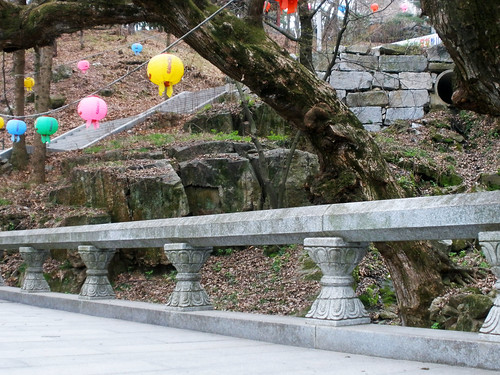
Lotus lanterns lining the path up to Gwanchoksa Temple in Nonsan, South Korea in early April. They made a colorful addition to an otherwise gloomy and winter shrouded woods.
In Korea, 석가탄신일, literally the day of Buddha's birthday, is celebrated by lighting lotus lanterns. There is a Buddhist proverb that says, "Please attain Buddhism in your next lifetime by lighting a lantern in this life," and the entire peninsula is decorated with lanterns in the month leading up to the holiday. I visited Gwanchoksa Temple in early April and there were already lanterns lining the path up to the temple. By early May, I was walking home from school under strings of lotus lanterns hanging between the street lamps and electric poles. Then, on Buddha's Birthday, the lanterns are lit during an evening ceremony.
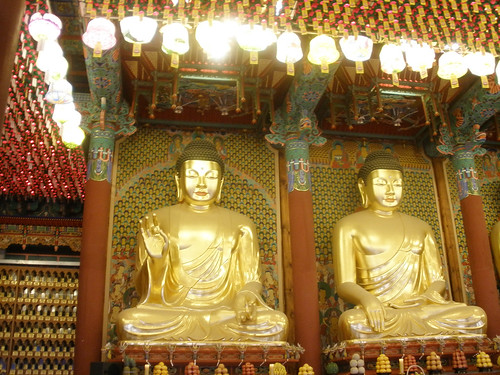
I watched the lighting ceremony at Jogyesa Temple in Seoul, the chief temple of the Jogye Order in Korean Buddhism. I met up with some friends outside of Jogyesa at 5:30, an hour and a half before the ceremony was suppose to start, and were given plastic bags for our shoes before shuffling into the temple. It's a small temple, with three golden Buddha statues sitting in the lotus position and a ceiling absolutely covered in red lotus lanterns. The decorations and painting were very similar to every other Korean temple I've visited. I'm always unsure how to behave in temples. To the people praying around me, the temple was a place of worship and this was a holy day, but all I was doing was sight-seeing and enjoying the scene. I never know the protocol on taking pictures - at least when sight-seeing at churches or cathedrals, it's my own religion that I'm disrespecting - but the temple was full of Koreans taking photos on their cell phones, so I pulled out my camera and no one rushed in to reprimand me. We stood in front of the Buddhas for a bit, and then left the temple. The temple is built on top of a stone platform a couple of feet high, and the stairs off the platform were flanked by stone ramps. Someone at the temple had attached a metal slide to one of the ramps, and a group of children were entertaining themselves by sliding down and shrieking with joy. I tried to stealthily take pictures of the cute, but taking pictures of other peoples' children is even trickier than figuring out if you're allowed to take pictures inside a temple.
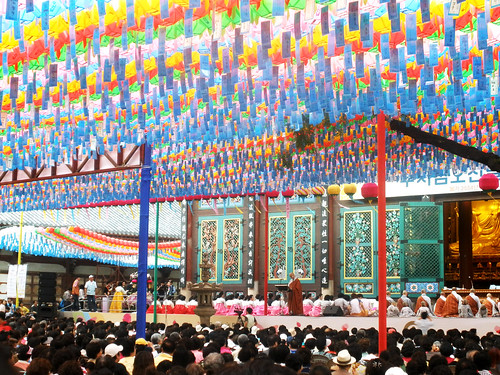
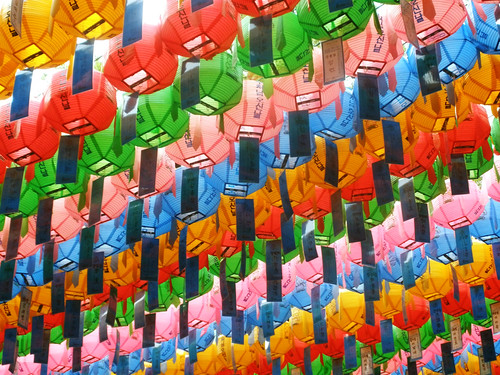
In front of temple is a large open courtyard which was covered with a canopy of lanterns. Even though we showed up early, the courtyard was packed with people. We eventually found a free spot amongst some bushes, and we sat down to wait. Marie, Omega and I are all knitters, so we pulled out knitting to entertain ourselves. This immediately made us a spectacle to the Koreans surrounding us, and one man started taking photos of the crazy 외국인, but considering I had just attempted to take pictures of young Korean children playing, I don't feel like I have the right to be annoyed. The ceremony itself started at seven and lasted for about forty five minutes. It mostly involved chanting and droning and throat-singing, all in Korean. It was dull, since I couldn't understand what was being said and I don't know enough about Buddhism to understand the significance of the ceremony. I did catch the occasional word in the mantra - teacher! student! fifty seven! - but other than that, I feel into a bit of a trance. My favorite part was at the very beginning, when the acolytes (or as I called them Tiny Baby Monklets!) scampered across the stage to take their place kneeling behind the monks.
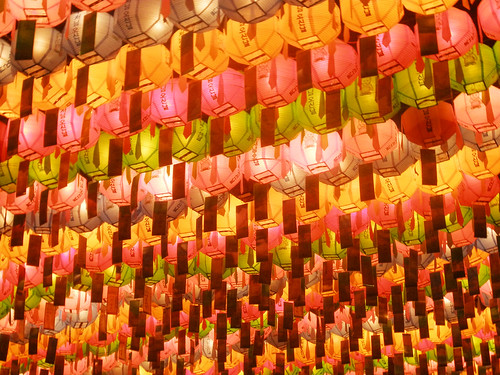
The ceremony ended around 7:45 and we had a fifteen minute wait until it was dark enough for the lantern lighting ceremony. Everyone stood up and chanted the four elements. (I only understood water and fire, but I assume the other two words were wind and earth.) The first few rows of lanterns were lit. We chanted the elements again and the second tier of lanterns were lit. We chanted a third time and the rest of the lanterns were lit. It only took twenty or thirty seconds, but it was absolutely amazing. Standing in the dark, watching the lanterns light up overhead, being surrounded by a huge crowd of devout people and actually being able to participate in someway, even if it was only four words, was extremely cool and it's something I'll remember for a long time. I'm so glad I went!
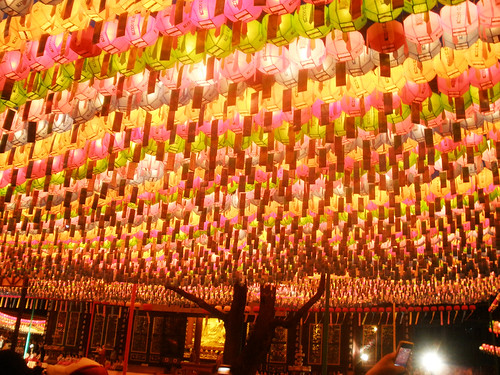
My favorite part of this picture is the bottom right corner, where you can see people taking pictures with their camera phones. It's such a very very typical Korean response and it makes me grin.
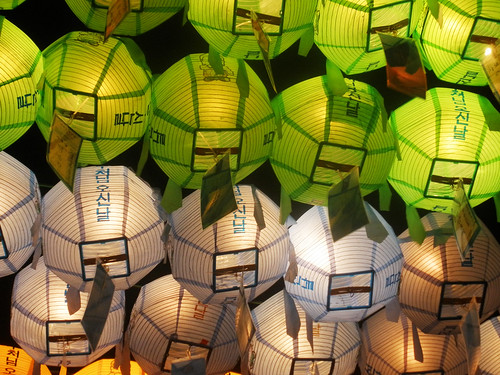
Full set of pictures are here.
Saturday, June 19, 2010
The Shouts of the Reds!

(From left to right: Riah, me and Siobhain at Thursday game.)
It is World Cup season! I realize that no one really cares back home, but South Korea cares passionately and in the weeks leading up to the opening ceremony, I couldn't avoid the bombardment of Red Devil paraphernalia or the overwhelming surge of patriotic pride. (I count at least five different Kpop groups who have recorded World Cup songs in the past few months.) Say what you like about Korea, there are few countries that are better at INTENSE NATIONALISTIC PRIDE! The Shouts of the Red, Be the Devils, KOREA FIGHTING, etc, etc!! Then I caught the opening match at the skewered food house across the street (they will wrap asparagus in bacon and serve it onna stick) and remember, right, I both truly enjoy watching soccer AND, thanks to years of watching my brother's soccer matches, it's the one sport where I actually understand what is going on. And thus I very quickly found myself DEEPLY INVESTED in the World Cup and the Red Devils of Korea.
I watched the first game at a bar up in Sinchon with some friends. It was truly miserable weather - it poured rain all day long - but tons of people still turned out to watch the glorious, glorious game. The bar had been reserved for a friend's birthday, so we were able to actually have seats for the game and room to dance about and bang clappers. Our bar was showing the game was on a fifteen second delay for some reason, which meant we heard the roar of the crowd upstairs when Korea scored their first goal and had a very confused fifteen seconds until our feed caught up. After that we opted to make as much noise as possible to drown out the sounds of any potentially spoiling celebrations from upstairs. Korea won 2-0 and it was wonderful and the rain let up long enough for people to dance in the streets afterwards.
I watched Thursday's game against Argentina at COEX mall. (One of my fourth graders ran up to me in class on Thursday, wearing a Korean soccer jersey and covered in temporary tattoos, and shouted, "BE THE DEVILS, TEACHER! FIGHTING KOREA!" If I hadn't already been excited, their enthusiasm would have been contagious.) The Korea National Football Team Supporters Club erected several huge screens outside COEX and despite the terrible yellow dust and smog and heat, thousands and thousands of people turned up to fill the streets outside of COEX and cheer. Being in that enthusiastic of a crowd for a game I actually cared about was loads of fun, at least until the match turned into a bloody rout in the last fifteen minutes. Halftime, though, was especially fun, since Korea scored a goal just seconds before the buzzer sounded and the entire break turned into one prolonged celebration of the goal.

A boy and his vuvuzela. In the background, people are waving clappers, inflatable plastic tubes handed out at any Korean sporting match and are banged together to make a WHOLE LOT OF NOISE.
(You guys, that game. It was a heartbreaker. Like, I knew Korea wasn't going to beat Argentina. No one really thought Korea was going to beat Argentina, not even my die-hard soccer fan co-teacher. But for the middle thirty-five or forty minutes the Korean team played SO WELL and I really thought it might end in a tie. They were holding their own against Argentina, especially for the first half of the second quarter, and then the Korean defense completely fell apart in the last twenty minutes and it ended in a bloody 4-1 rout and seriously, BREAK MY DAMN HEART, why don't you. I don't think I've ever seen a more depressed subway packed full of people. BUT, Greece beat Nigeria, and we trounced Greece, which means there's STILL HOPE for advancing. Unfortunately, the South Korea vs. Nigeria game is at 3:30 Wednesday morning, which means I can't watch the game and be ~functional~ the next day, but I'm still VERY EXCITED!)
(And don't even get me started on the US-Slovenia match. I didn't even watch it since the US games have so far had the bad fortune of starting very late at night in Korea, but seriously, WHAT WAS THAT! We were robbed and I'm very possible going to have to stay up to cheer during the US-Algeria game on Wednesday.)
(God, I LOVE soccer!)
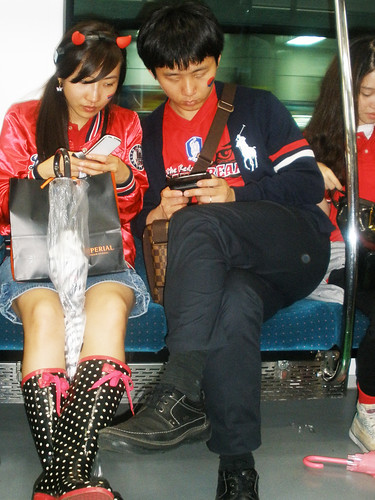
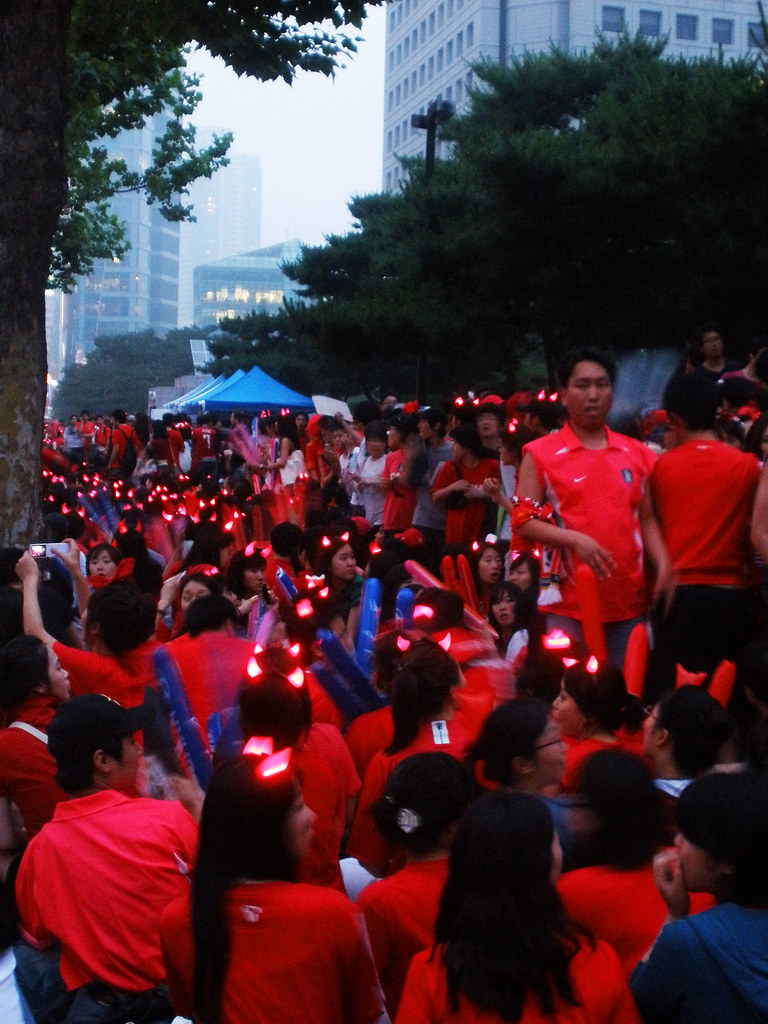
Light-up devil horns are a popular accessory for any Red Devil fan! On the left: fans heading home after the Korea-Greece game. On the right: fans lining the streets outside of COEX before the Korea-Argentina game.

The clappers are especially useful when chanting. Throughout the game, someone would shout Daehanminguk, the official Korean name for the Republic of Korea, and the crowd for respond, "Daemanminguk! CLAPCLAP - CLAPCLAP - CLAP" This went on for approximately the ENTIRE GAME.
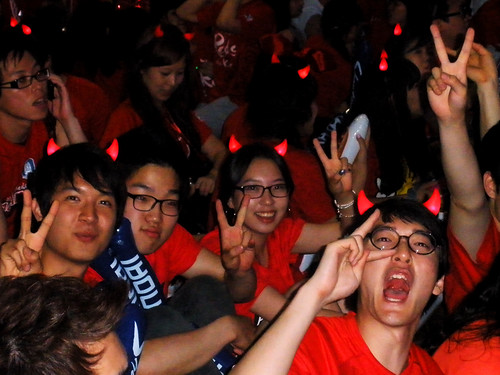
THE SHOUTS OF THE REDS! FIGHTING KOREA!
More photos and videos are here.
Friday, May 21, 2010
석가탄신일 (Buddha's Birthday)

Lanterns decorating Jogyesa Temple in Seoul on Buddha's Birthday, May 21st.
Happy Birthday, Buddha! Glad to see you made it another year. Thank you for the day off and I had a great time at the party. It was the sort of day that left me with a pleasant buzz of happiness in the pit of my stomach and good will towards mankind, which is probably a fitting way to celebrate the birth of The Enlightened One. Granted my dinner of sausage/mashed potatoes/beer wasn't typical Buddhist fare, but it was delicious.
PS. Loved the decorations!
Sunday, March 14, 2010
Racism in Korea
As part of the public school curriculum, I'm suppose to show certain video clips during my lessons to "teach" the students. They're mostly pretty bad and often unintentionally hilarious - there are some examples here, here and here - but aside from teaching poor pronunciation and awkward (and sometimes flat out incorrect) phrasing, and making me snort in the middle of class, they aren't actually harmful. Right?
Last week, I taught a lesson with a claymation fashion show. The video shows the three contestants being interviewed about where they're from and what they like, illustrating the key expression of the lesson - where are you from? I previewed the video before class and the first two contestants were all right. Nami's from Korea and she likes kimchi, gee that's original. Ann is a basketball playing cowgirl from the USA. Okay, I guess those are both facets of our cultural heritage, albeit two that rarely meet. And then I saw Miss Uganda, Jane.

Oh my holy hell. That's blackface. That's CLAYMATION BLACKFACE! And while there is at least the other two characters are dressed in the "native costumes" and a token reference is made to the represented cultures, Jane is stuck in some Tarzan-esque loincloth and tells the MC how she had fun visiting her uncle in Japan. I've lost count of the number of things that's wrong with this scene.
Any expat will tell you that Korea can be a racist society - against foreigners in general and people with darker skin in particular. When my former school ask my opinion on their perspective new native teachers, I was bluntly told they wanted someone white. I've even seen blackface in advertising before. Korea was a hermit country for a long time and they seem to be far behind the West in terms of race relations. (I am in no way suggesting that there isn't racism in America, just that we've reached a point where it is generally viewed as a bad thing.)
It took me a while to articulate why I am so enraged by this. I've been in Korea long enough to no longer be shocked by Korea's prejudices and it's not like I expected my sixth graders' textbook to an advocate for cultural sensitivity, but the fact still remains that this is part of the national curriculum, which means that multiple people, all of whom presumable have some passing familiarity with Western culture, saw this sketch and approved it. This isn't some one off gimmick thought up by some jackass in marketing as a tool to sell more ice cream bars. This isn't the racism of an individual person, like my old principal telling me he would only hire a white woman to replace me. This is a public institution choosing to turn an entire culture into a cheep laugh from bored students. This is an institutionalized racism that's being taught to children, and it made me pull at my hair in rage and frustration.
Last week, I taught a lesson with a claymation fashion show. The video shows the three contestants being interviewed about where they're from and what they like, illustrating the key expression of the lesson - where are you from? I previewed the video before class and the first two contestants were all right. Nami's from Korea and she likes kimchi, gee that's original. Ann is a basketball playing cowgirl from the USA. Okay, I guess those are both facets of our cultural heritage, albeit two that rarely meet. And then I saw Miss Uganda, Jane.

Oh my holy hell. That's blackface. That's CLAYMATION BLACKFACE! And while there is at least the other two characters are dressed in the "native costumes" and a token reference is made to the represented cultures, Jane is stuck in some Tarzan-esque loincloth and tells the MC how she had fun visiting her uncle in Japan. I've lost count of the number of things that's wrong with this scene.
Any expat will tell you that Korea can be a racist society - against foreigners in general and people with darker skin in particular. When my former school ask my opinion on their perspective new native teachers, I was bluntly told they wanted someone white. I've even seen blackface in advertising before. Korea was a hermit country for a long time and they seem to be far behind the West in terms of race relations. (I am in no way suggesting that there isn't racism in America, just that we've reached a point where it is generally viewed as a bad thing.)
It took me a while to articulate why I am so enraged by this. I've been in Korea long enough to no longer be shocked by Korea's prejudices and it's not like I expected my sixth graders' textbook to an advocate for cultural sensitivity, but the fact still remains that this is part of the national curriculum, which means that multiple people, all of whom presumable have some passing familiarity with Western culture, saw this sketch and approved it. This isn't some one off gimmick thought up by some jackass in marketing as a tool to sell more ice cream bars. This isn't the racism of an individual person, like my old principal telling me he would only hire a white woman to replace me. This is a public institution choosing to turn an entire culture into a cheep laugh from bored students. This is an institutionalized racism that's being taught to children, and it made me pull at my hair in rage and frustration.
Wednesday, September 16, 2009
Gyeongju, Day 2
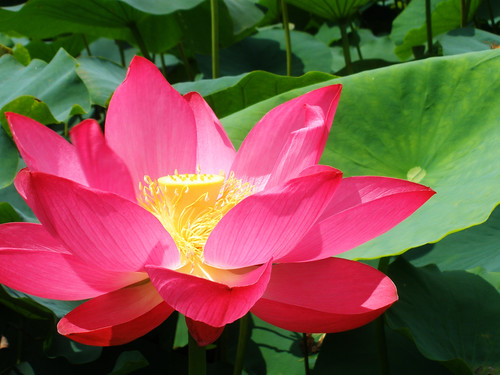
The original plan was to wake up early and go see a temple. That lasted right up until the alarm went off and Sarah and I promptly decided no thanks, we would rather sleep for another two hours. Story of her visit. We finally made it out of the hotel by eleven and set off to explore Gyeongju. Our first stop was Tumuli Park.
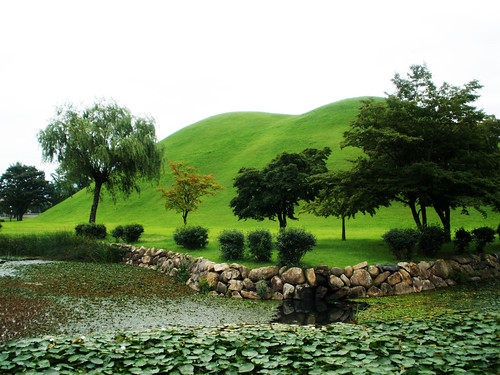
Tumuli are tombs from the Silla dynasty, which lasted from 57 BC to 935 AD. Tumuli Park has twenty three tombs of Silla royalty. The tumuli look like large grassy mounts and they're all over Gyeongju. Many of the tombs have been excavated and the largest tomb is open to visitors, with reproductions of the burial and some of the treasures, but mostly all you see are the grassy hillocks. They're immaculately maintained and there were flowering trees surrounding the tombs, but there wasn't much to actually see.
Our next stop was the 7-11, where we scrounged together a breakfast of Denish pastries (not a typo), some sort of blueberry cream cheese sandwich thing and nuts. Eating was a bit of an adventure in Gyeongju. While Sarah was here, we ate mostly western food. Korea is not an easy place to eat if you're vegetarian and since Tonga doesn't really have restaurants, Sarah was understandable more interested western food that wasn't normally available to her than trying to figure out what Korean food she could eat. That's all fine and dandy when we were in Seoul, but western food (at least, non Korean/western fusion food [*shudder*]) was far more difficult to find once we left the capital. A lot of our meals were pretty hit or miss.

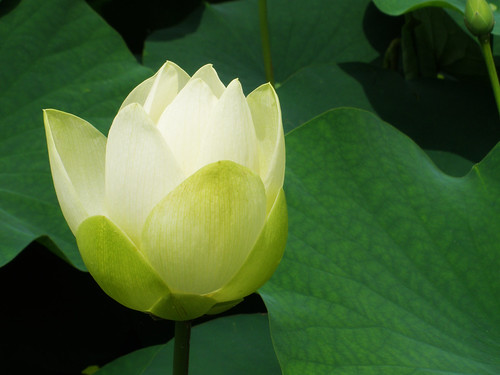
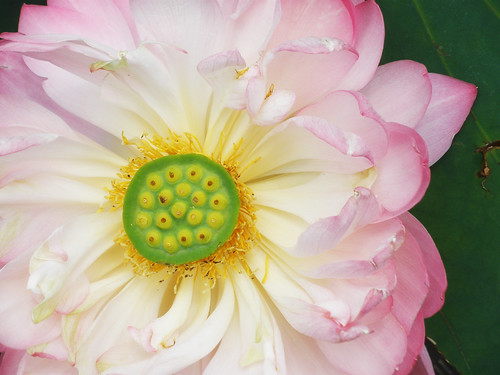

After breakfast we went to Anapji Pond. Anapji Pond was built as a pleasure garden by King Manmu in 674. The buildings have been destroyed, but the pond is full of lotus blossoms. It's a really lovely spot, if very crowded. Sarah and I spend another hour wandering around, taking pictures of lotus blossoms.
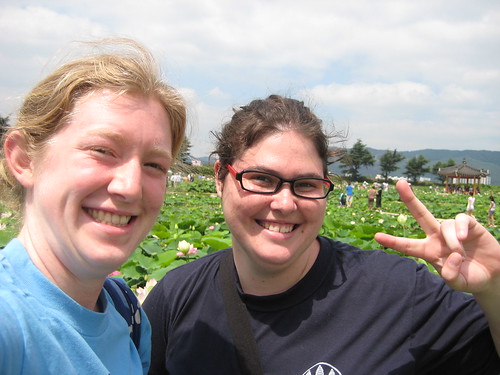
We also did the whole "posing in front of cultural monument so we could take a self portrait and sent it home to our parents in an attempt to convince them we're not dead yet" thing and, well, it ended poorly. We posed crouching down on some stepping stones making a path through the pond and as we were standing up, I overbalanced and toppled backwards into the pond. Luckily my purse didn't get (too) wet and I didn't loose my shoes scrambling out of the pond, but I did end up looking like this:
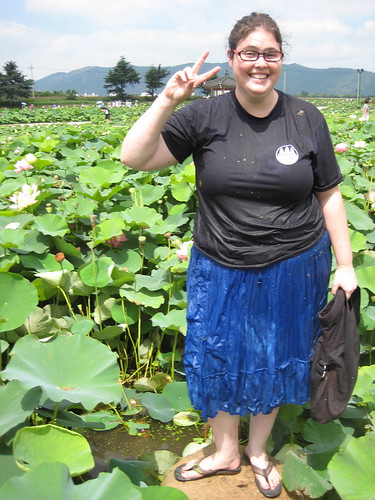
We (well, I) squelched back to our hotel, stopping briefly at Wolseong Park to see Cheomseongdae, the the oldest astrological observatory in the Far East.
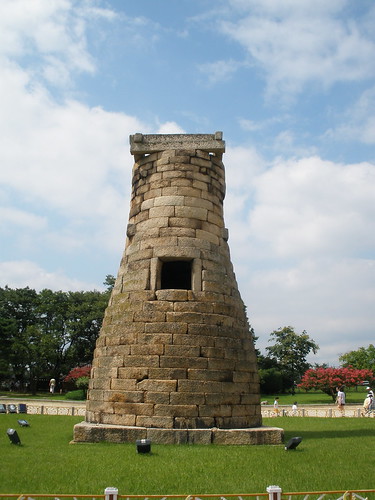
Once back at the hotel I tried to wash the worst of the mud and pond scum out of my clothes in the shower and while my stuff tried, Sarah and I hung out at the hotel for a few hours. The owner of the hotel told us about a free traditional music performance held at a nearby resort that we decided to check out. It was, to say the least interesting. There were a few good acts in the first half, but the second half was a Korean/western fusion band playing western songs on traditional Korean instruments. In theory that sounds interesting, but in practice it sounds like this:
Halfway through the song Sarah and I looked at each other and incredulously asked, "Is that ABBA?" There was also a visible drunk man in the audience who kept running onto the stage to try and dance with the performers. It was an unique take of traditional Korean music. On the way home, we stopped by the train station to buy our tickets for trip home well in advance. (That was a bit of an adventure. The ticket seller kept saying there was no train to Seoul that night and I kept repeating Tuesday over and over again, but we finally understood each other and got our tickets.)
The train station was across the town from where we were staying and as we got off the bus we heard a flurry of whispers from a large group of western tourists staying at the same hostel as us. "Wait, is this our stop? Why are they getting off? Should we get off?" The strangest thing about the trip was the tourists. They were everywhere! I don't normally see that many tourists in Korea, since I don't live in a touristy area or spend much time at tourist spots, but they were everywhere in Gyeonju and I kept being mistaken for one. They were loud and complained about how no one spoke English and kept obviously disregarding Korean culture and for a person who travels as much as I do, it turns out I'm an awful snob about people traveling in the country where I live.
The rest of the photos from the day are here.
Monday, September 7, 2009
Gyeongju, Day 1
 Another vacation post. (For the record, they're all being tagged I got Seoul after the chorus from the Killers song "All These Things That I've Done" because a) Seoul/Soul puns are even funnier now that I know the correct way to pronounce Seoul and b) I unapologetically love Hot Fuss, even though I know that makes me an emo hipster.) After a week in Seoul, Sarah and I decided to ventured out into the countryside and on Friday (08/01), we left for Gyeongju. If you look at the map, Ansan (where I live) is the blue pen and Gyeongju is the green pen. Gyeongju was the capital of the Silla Empire, which lasted for nearly a thousand years (from 57 BC - 935 AD). At its height, Gyeongju had nearly a million inhabitants and was the capital of the entire Korean peninsula for 300 years. It's full of tombs and temples and pagodas and lotus ponds. That last one will be important later.
Another vacation post. (For the record, they're all being tagged I got Seoul after the chorus from the Killers song "All These Things That I've Done" because a) Seoul/Soul puns are even funnier now that I know the correct way to pronounce Seoul and b) I unapologetically love Hot Fuss, even though I know that makes me an emo hipster.) After a week in Seoul, Sarah and I decided to ventured out into the countryside and on Friday (08/01), we left for Gyeongju. If you look at the map, Ansan (where I live) is the blue pen and Gyeongju is the green pen. Gyeongju was the capital of the Silla Empire, which lasted for nearly a thousand years (from 57 BC - 935 AD). At its height, Gyeongju had nearly a million inhabitants and was the capital of the entire Korean peninsula for 300 years. It's full of tombs and temples and pagodas and lotus ponds. That last one will be important later.The quick and dirty highlights version is we went to a lotus pond full of beautiful, delicate blossoms...

and I fell in. OF COURSE I DID! Was there any other way for that setup to end? If I were a stick figure drawn on the back of an Hello Kitty envelope, it would have looked something like this:

I Twittered about it that night (I'm in ur social network, connectin' with mah peepz), saying Today I fell in a lotus pond. Some days I feel like I really shouldn't be allowed out of the house without proper supervision. Several people responded, saying things like Doesn't Sarah count as proper supervision?, and the answer is no, no she doesn't. Trust me, it's more fun that way.
I originally planned to write about the entire trip to Gyeongju in one post, but that was taking too long to finish, so I'm going to do it day by day. (And also, Step by Step.)

Sarah and I left my apartment around ten and took a bus to Suwon, with plans of catching a train to Gyeongju from there. Suwon, the capital of the province I live in, is only twenty minutes away from me by bus and, as one of the primary suburbs of Seoul, a major transportation hub. We got to the train station by eleven, only to be told there were no tickets to Gyeongju until eleven that night. We decided to try our luck at the bus terminal and got tickets on a bus leaving at 4:40, leaving us five hours to kill in Suwon. We decided to check out the Hwaseong Fortress. Quick history lesson: Hwaswong Fortress, a UNESCO World Heritage Site, was built between 1794 and 1796 by King Jeongjo to honor his father. The fortress is primarily a wall that surrounds the inner city of Suwon with various gates and outposts along the perimeter.

We had a bit of an adventure actually finding the fortress and due to poor directions (we were told to get off HERE, with here being no where near where we wanted to be) and ended up wandering a couple of miles through Suwon, hoping to stumble upon some sort of fortification. We eventually found Paldalmun, the South Gate, and then located the rest of the fortress wall, up a very steep hill. By the time we made it to the top of the fortress, we were hot, sweaty and a bit cross, which is probably why we opted to ride the Dragon Trolley with a bunch of children instead of walking along the fortress. I'm pleased to report that the Dragon Trolley is just as awesome as it looks and I a met a very nice Korean boy who told me all about his favorite comic after a bit of prompting from his dad.


After the trolley ride, we doubled back to get a closer look at the northern stretch of the fortress. I hiked along the southern stretch when I first moved to Korea, but I didn't make it this far around. The Suwoncheon (Suwon River) runs through the middle of the city. The Hwahongmun is one of the two floodgates that lets the river through. The whole area was very picturesque, with the traditional eves painting and the walls and parapets and children splashing in the river. Less picturesque was this sign:

Careful, drivers. Don't drive off this very obvious embankment into the river. (I laugh, but given how Koreans drive [hint: craaazy], it's a pretty reasonable warning to give.) Given our difficulties finding the fortress and the subsequent trolley ride, we left for the bus station well in advance, only to decide to catch a taxi (screw you, bus!) and arrived at the bus terminal with time to spare. We sampled the different bakeries for an early dinner and left Suwon by 5:00. The bus ride was long. The only two adjacent seats were in the middle of the very back row, which means no arm rests, air vents or seat lights. Not even a window to lean against and gaze out. We spent the first hour of the trip stuck in Seoul traffic and two hours into the trip, the overhead lights on the bus were turned off, meaning we couldn't read. (I may have exclaimed, "Hey!" angrily when the lights went out, earning me several dirty looks from my fellow passengers trying to sleep.) Without an air vent the heat was stifling and the teenage girl I was sitting next to (who did have an air vent) kept pushing her fleece blanket onto my lap.
We arrived in Gyeongju late and found small, curly black hairs all over the floor of our room, but the hostel had held our reservation and after a quick trip to the local grocery store for a mini-broom, we cleaned our room and went to bed. The rest of the photos from Suwon can be found at the bottom of here.
Subscribe to:
Posts (Atom)
